Evidence from Roman Imperial times is constantly being unearthed in archaeological excavations around the Mediterranean. The newly-discovered structures and artifacts frequently hold information that can teach us more about the people of antiquity. Since the Christian (New) Testament has been so influential in the history of the West, scholars who study Christian Testament texts and related literature (such as Christian literature that did not make it into the canon, church leaders’ documents, and imperial edicts), using archaeological evidence to inform what is known through literary sources becomes very informative.
Here are five groups of finds (from two continents) and their significance for the study of the early church and the history of the West.
Anatolia
Those familiar with the Bible are probably acquainted with the town of Ephesus on the West coast of what is now Turkey. As we have noted, the letter to the Ephesians in the Christian Testament, traditionally attributed to St. Paul but written long after his death, contains powerful passages often read during church services. Ephesus is the setting in Acts 19 where Paul and his companions clash with worshipers of the great goddess Artemis. Today, Ephesus is “one of the largest and best-preserved cities from the classical period and is one of the leading archaeological sites in the Mediterranean.”
Elsewhere in this region, known in antiquity as Anatolia or Asia Minor, other sites had also long had connections with Greece and Rome. Recent excavations at Lagina, near Stratonicea (Caria), have uncovered an ancient cult to the goddess Hecate. Hecate was widely revered throughout the Graeco-Roman world because of her role as a protector and her ability to ward off evil forces. Women especially prayed to Hecate to help them conceive, go through labor and care for their children. Like other female deities that we have examined, Hecate was viewed as very powerful, over both life and death.
Excavations at the sanctuary at Lagina have uncovered rare if not unique characteristics of Hecate compared to those found elsewhere. A new temple built of marble in the second century CE, following an earthquake that destroyed the earlier temple, was four-sided, decorated with friezes honoring Hecate. Significantly only “at Lagina is Hecate positioned at the center of the scene [of several gods] as a primary actor in this pivotal moment” of the mythological story (Bouscaren, 27). In another scene, Hecate oversees a meeting between Greek soldiers and Amazons. Also in this scene is the goddess Roma, the personification of the Roman Republic. Archaeologists surmise that some of this symbolism was connected with “Anatolia’s complex political situation during the Hellenistic period,” resulting in citizens’ need to figure out their social and even religious identities (Bouscaren, 27).
Greece: Thessaloniki
In a subway system project in the northern Greek city of Thessaloniki that has taken 22 years to complete, archaeologists have found more than 300,000 treasures from the Roman, Byzantine and Ottoman eras. 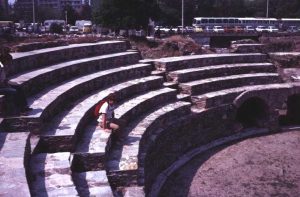 The finds are now on display in 13 “archaeo-stations” across the system.
The finds are now on display in 13 “archaeo-stations” across the system.
Among the discoveries that pertain to the ancient Christian world include water and drainage systems, water being essential to the lives not only of rulers but also everyday inhabitants of this important city. Ancient Greek burial sites “brimming with jewellery and gold” were also uncovered, as was an early Christian basilica.
Under the Venizelos station, visitors can now see part of the “Decumanus Maximus, the main Roman road that traversed Thessaloniki from the Vardar River to the area of the present-day universities.” This road was known as the Via Egnatia in antiquity, which we explored earlier in conjunction with the influence of goddess cults on the early Jesus movement. This section of the newly-excavated road at Thessaloniki was “a vibrant commercial artery lined with stalls, kiosks, and shops.” As with other digs throughout the Roman Empire, finds from these excavations included cobbled streets, building foundations, scattered stones and beautiful mosaics. Modern Thessalonians and visitors to the city are fortunate now, when riding the subway or even just visiting the stations, to be able to picture the shops, homes, and workshops that were so much part of life in ancient times.
A major reason that Thessaloniki and its ancient artifacts are so important to Christian Testament scholars and early church historians is its close association with St. Paul. There are two letters in the Christian Testament supposedly written by Paul to the Thessalonians. Significantly, however, most mainstream scholars date only the so-called First Letter to Paul (that is, 50-60 CE); the Second Letter is dated instead to 80-100 CE. This is important because II Thessalonians is most likely a forgery and promotes different theological perspectives, as well as demonstrating deviations in vocabulary, literary style, and tone from I Thessalonians (Friesen, 189, 197). ![]() This should not be surprising if they were written and circulated up to 50 years apart, but many scholars, religious leaders and lay Christians wrongly believe that Paul wrote both letters. The new finds at Thessaloniki again cause us to ensure that we have the most up-to-date information about these two early epistles and the overall context of the city.
This should not be surprising if they were written and circulated up to 50 years apart, but many scholars, religious leaders and lay Christians wrongly believe that Paul wrote both letters. The new finds at Thessaloniki again cause us to ensure that we have the most up-to-date information about these two early epistles and the overall context of the city.
Greece: Philippi
We have examined the city of Philippi on several occasions. Philippi, 100.3 miles (161 kilometers) east of Thessaloniki, also lies on the Via Egnatia. As we have noted, goddesses and their cults featured prominently in the cities along this vital route during the time of Paul and other Jesus missionaries; Christianity is heavily male-oriented, so bringing the worship of female deities to mind is extremely important. Furthermore, worship of these Graeco-Roman deities survived long after the first century, putting the lie to the traditional narrative that Christianity spread and took firm hold fairly rapidly.
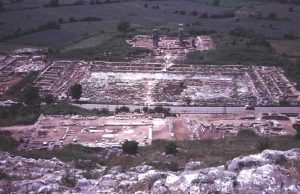 In Philippi, from Colonia Augusta to Communitas Christiana: Religion and Society in Transition, contributors confirm these observations with archaeological evidence from recent explorations. The essays examine Philippi’s diverse and complex religious environment – encompassing not only Roman, Greek and Thracian cultic practices but also Anatolian and Egyptian – and illuminate the wide ethnic hybridity in Roman Imperial times.
In Philippi, from Colonia Augusta to Communitas Christiana: Religion and Society in Transition, contributors confirm these observations with archaeological evidence from recent explorations. The essays examine Philippi’s diverse and complex religious environment – encompassing not only Roman, Greek and Thracian cultic practices but also Anatolian and Egyptian – and illuminate the wide ethnic hybridity in Roman Imperial times.
Other observations about Philippi in the volume include consideration of the local cult hero, Auloneites, and the sacredness of his site into the early Byzantine era; the role of enslaved persons, who participated in trade and public and private associations; and the observation that some religious activities in antiquity were conceptualized in transactional economic terms, as revealed through a study of the god Sylvanus (whose sanctuary was on Philippi’s acropolis hill). Other articles focus on funerary inscriptions, the five or more basilicas at Philippi that illustrate the city’s function as a pilgrimage site (probably related to St. Paul’s legacy if not actual life), and recent excavations of residential areas.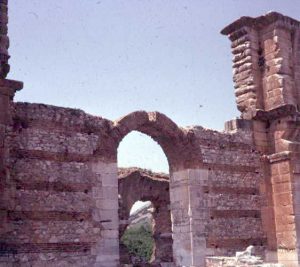
In the words of reviewer Jeehei Park, the volume’s contributors offer “an innovative yet thoroughly grounded engagement with and interpretation of the material world of ancient Philippi.” The authors compellingly argue that physical evidence is essential for illuminating how early Christians navigated their lives “as artisans, small business owners, public officials, and enslaved laborers.”
Italy: San Casciano dei Bagni
In the Tuscany region and Province of Siena in Italy, about 68 miles southeast of Florence, lies the municipality of San Casciano dei Bagni. In late 2022, archaeologists discovered over a dozen bronze statues dating from the second century BCE. The statues, which were covered by 6,000 bronze, silver, and gold coins in excellent condition, bear dedications to gods including Apollo, Asclepius, Hygeia, Isis, and Fortuna Primigenia – all associated with health and healing.
While these artifacts date from two centuries before the time of Jesus and Paul, they do inform the larger social and religious context of this region. Archaeologists were long aware of the existence of a thermal spa nearby, and that both Etruscans and Romans honored it as sacred, but not until these current excavations did it become evident that the entire area was a sanctuary. Objects found that had been offered to these healing deities – both male and female – included bronze coins, trees, branches, and fruits. As we have noted in the past, healing and health, especially as related to female deities, are closely tied to water. 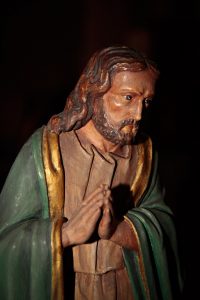 Healing miracles of Jesus and the early disciples, as recounted in the Gospels, Acts of the Apostles, and much extra-canonical literature, would not have been foreign to those hearing the Jesus message. In fact, if the Jesus message did not include healing and concerns about health, the message would most likely have fallen on deaf ears.
Healing miracles of Jesus and the early disciples, as recounted in the Gospels, Acts of the Apostles, and much extra-canonical literature, would not have been foreign to those hearing the Jesus message. In fact, if the Jesus message did not include healing and concerns about health, the message would most likely have fallen on deaf ears.
That the site was used from the first through the fifth centuries CE, by both pagans and Christians, show once again both the coexistence of a mix of people in a Roman-era locale and the persistence of Graeco-Roman practices well into the Christian era. Any missionaries from the early Jesus movement who may have stopped here would have encountered worshipers of these deities and the rites that they practiced. When contemplating the growth and influence of the Jesus message in a place such as San Casciano dei Bagni we must always take the fuller context into account; any consideration of “conversion” must acknowledge the staying power of the local traditions, no matter how persuasive the pro-Christian evidence might appear.
Italy: Rome
Finally, let us look at some areas under Rome and its suburbs for additional insights into the ancient world and its people. While the catacombs and other underground spaces have been known for centuries, excavations for a movie theater between 1999 and 2001 uncovered a new section of the only aqueduct still functioning since the original 11 of the Roman era. Over the past two decades, two groups of a different type of explorer – speleo-archaeologists, who explore caves and other dark underground areas – are bringing to light to scholars and the public many important, lesser-known discoveries. Smithsonian magazine took readers on a tour of these discoveries in its April-May 2025 issue (Perrottet, passim).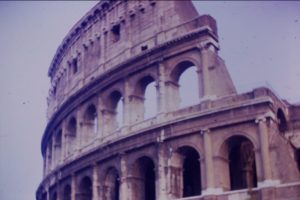
Rome, of course, is crucial in the history of the Jesus movement and the growing religion that became Christianity. Paul’s Letter to the Romans, probably the last of his seven authentic epistles, written between 50 and 60 CE, is a major text of the early Jesus movement. Rome was the location of an early Jesus community (probably earlier than Paul), the presumed site of Paul’s martyrdom, and of course the city of the Popes. Tourists can easily visit many of the archaeological sites in the city that pertain to the early Empire and the growth of Christianity.
What is significant but not as well known are those underground finds highlighted in the Smithsonian article. Author Tony Perrottet describes the following (some of which are illustrated by photographer Paolo Verzone):
- The Cloaca Maxima, the magnificent sewer that is not only an engineering marvel of antiquity but that still functions today
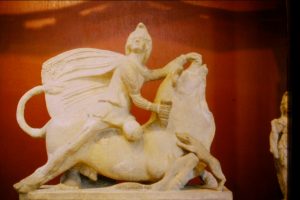 A Mithraeum, an altar dedicated to the pagan god Mithras, probably from the first century CE
A Mithraeum, an altar dedicated to the pagan god Mithras, probably from the first century CE- Ancient mosaic floors
- A Roman apartment complex
- Nine different types of wall
- Embedded terra-cotta pipes
- Human remains, including a skull
- A large reservoir where water was stored, and from where water still flows
- 15 stone arches of an aqueduct extending almost 200 feet
According to earth scientist Giuseppina Mattietti of George Mason University near Washington, DC, the oddities and other finds from underground Rome are as important to understanding the ancient city as the better-known, major monuments. The humble dwellings help expand our knowledge of “the real Romans who made up 90 percent of the population” (Perrottet, 119). These “real Romans” would include early Jesus followers and missionaries, as well as their pagan neighbors.
Summary
The discoveries and novel methods of exploring sites that we have examined here amplify a number of take-aways for the study of the Jesus movement and the beginnings of Christianity.
- Professional excavations, including those at little-known sites, are routinely turning up new – and often very interesting – information and data that can be examined.
- Material culture supplements what we know (or think we know) from the Christian Testament texts and other early Christian literature.
- Evidence from religious sanctuaries and Graeco-Roman deities broadens our understanding of what and whom the early Jesus missionaries may have encountered.
- Archaeological excavations remind us that Jesus’ missionaries’ neighbors were not just the men whose names we find in the texts but also women, many of whom held leadership positions.
- Even sites that have been known and studied for decades, if not centuries, can yield novel information.
- New finds – some extremely tiny – can expand traditional understandings, open different avenues for exploration, and raise new questions.
Christian Testament scholarship owes a debt of gratitude to the researchers who bring these discoveries to light and the individuals, organizations and government agencies that provide financial and other support.
Resources
Bouscaren, Durrie. “Goddess at the Crossroads: Why a city put its trust in a Greek deity feared throughout the Mediterranean world,” Archaeology, Vol. 78, No. 3 (March/April 2025) 22-27.
Friesen, Steven J. “Second Thessalonians, the Ideology of Epistles, and the Construction of Authority: Our Debt to the Forger,” in Laura Nasrallah, Charalambos Bakirtzis and Steven J. Friesen, editors, From Roman to Early Christian Thessalonikē: Studies in Religion and Archaeology, 189-210. Cambridge, MA: Harvard University Press, 2010.
Greek City Times, December 1, 2024.
Kirby, Peter. “Early Christian Writings: New Testament, Apocrypha, Gnostics, Church Fathers.”
Lobell, Jarrett A. “Sacred Spring, San Casciano dei Bagni, Italy,” Archaeology (January/February 2024).
Park, Jeehei. Review: Steven J. Friesen, Michalis Lychounas, and Daniel N. Showalter, eds., Philippi, from Colonia Augusta to Communitas Christiana: Religion and Society in Transition (Leiden: Brill, 2022) in Review of Biblical Literature, March 2025.
Perrottet, Tony. “The City Beneath the City,” Smithsonian, Vol. 56, No. 01 (April-May 2025) 110-24.
